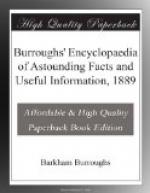FORCED TOMATOES.—Prepare the following forcemeat: Two ounces of mushrooms, minced small, a couple of shalots, likewise minced, a small quantity of parsley, a slice of lean ham, chopped fine, a few savory herbs, and a little cayenne and salt. Put all these ingredients into a saucepan with a lump of butter, and stew all together until quite tender, taking care that they do not burn. Put it by to cool, and then mix with them some bread crumbs and the well beaten yolks of two eggs. Choose large tomatoes, as nearly of the same size as possible, cut a slice from the stalk end of each, and take out carefully the seeds and juice; fill them with the mixture which has already been prepared, strew them over with bread and some melted butter, and bake them in a quick oven until they assume a rich color. They are a good accompaniment to veal or calf’s head.
TO MASH TURNIPS.—Boil them very tender. Strain till no water is left. Place in a saucepan over a gentle fire, and stir well a few minutes. Do not let them burn. Add a little cream, or milk, or both, salt butter and pepper. Add a tablespoonful of fine sugar. Stir and simmer five minutes longer.
TO BOIL OR STEW VEGETABLE MARROW.—This excellent vegetable may be boiled as asparagus. When boiled, divide it lengthways into two, and serve it upon a toast accompanied by melted butter; or when nearly boiled, divide it as above, and stew gently in gravy like cucumbers. Care should be taken to choose young ones not exceeding six inches in length.
* * * * *
[Illustration: How to Calculate]
HOW TO CALCULATE.
PRACTICAL RULES, SHORT METHODS, AND PROBLEMS USED
IN BUSINESS
COMPUTATIONS.
Rapidity and accuracy in making estimates and in figuring out the result of business transactions is of the greatest necessity to the man of business. A miscalculation may involve the loss of hundreds or thousands of dollars, in many cases, while a slow and tedious calculation involves loss of time and the advantage which should have been seized at the moment. It is proposed in the following pages to give a few brief methods and practical rules for performing calculations which occur in every-day transactions among men, presuming that a fair knowledge of the ordinary rules of arithmetic has previously been attained.
ADDITION.
To be able to add up long columns of figures rapidly and correctly is of great value to the merchant. This requires not only a knowledge of addition, but in order to have a correct result, one that can be relied upon, it requires concentration of the mind. Never allow other thoughts to be flitting through the mind, or any outside matter to disturb or draw it away from the figures, until the result is obtained. Write the tens to be carried each time in a smaller figure underneath the units, so that afterwards any column can be added over again without repeating the entire operation. By the practice of addition the eye and mind soon become accustomed to act rapidly, and this is the art of addition. Grouping figures together is a valuable aid in rapid addition, as we group letters into words in reading.




